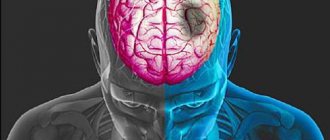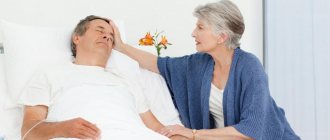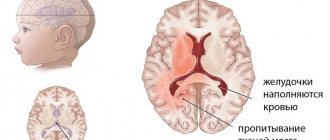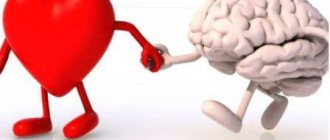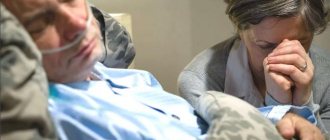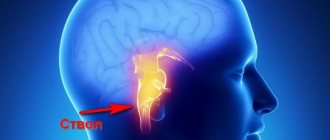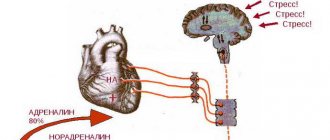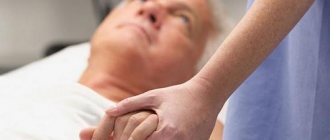What is a hemorrhagic stroke, how is it different from an ischemic stroke?
Hemorrhagic stroke is a type of vascular accident in the brain that develops as a result of a rupture of an artery or vein or a violation of the permeability of the vessel wall. With this pathology, hemorrhage occurs in the brain, and with ischemic stroke, on the contrary, a deficit of cerebral circulation occurs.
Difference between ischemic and hemorrhagic strokes
Hemorrhagic stroke is also called non-traumatic intracerebral hemorrhage.
The risk group includes people 40–60 years old who have high blood pressure, atherosclerosis and congenital cerebral vascular defects.
Prevention
Preventive measures aimed at preventing the development of hemorrhagic stroke are also used to eliminate the likelihood of relapse of the disease. The basic rules for preventing pathology include:
- exclusion of fatty, fried and spicy foods from the diet;
- regular blood pressure monitoring;
- maintaining a healthy lifestyle;
- avoidance of stressful situations;
- compliance with the instructions of the attending physician;
- timely treatment of concomitant pathologies;
- rejection of bad habits.
Repeated hemorrhagic stroke excludes the possibility of returning to a socially active life and often ends in death. If you notice any symptoms of the disease, you should immediately seek help from a doctor. He will diagnose the pathology and prescribe the most effective treatment tactics, which will prevent the development of severe complications and restore lost brain functions.
Classification
According to the tenth International Classification of Diseases (ICD-10), types of hemorrhagic stroke are usually divided based on the location of the disease. Based on this criterion, four types of pathology are noted, which, in turn, are divided into subgroups:
- Parenchymatous. Characterized by the outpouring of blood into the substance of the brain. They are one of the most severe forms of cerebral bleeding. Lead to profound neurological deficits. There can be two types - hematoma (limited accumulation of blood) and hemorrhagic impregnation. The following forms of parenchymal hemorrhages are distinguished:
- hemispheric. They are right- or left-sided, depending on which hemisphere is damaged;
- subcortical. This type of lesion occurs when blood gets under the gray matter of the brain;
- cerebellar;
- stem;
- pavements.
- Subarachnoid. Characterized by hemorrhage into the subarachnoid membrane of the brain. Highlight:
- basal - hemorrhage on the lower surface of the hemispheres, with the anatomical integrity of the skull bones;
- convexial - hemorrhage into the convex surfaces of the brain.
- Ventricular (ventricular). Characterized by bleeding into the ventricles of the brain.
- Mixed. When various combined hemorrhages are detected.
The sooner the rehabilitation process begins, the higher the chances of reducing the consequences of the disease.
Stages of hemorrhagic stroke - table
| Stage name | Duration of flow |
| Acute | The first twenty-four hours after the onset of stroke |
| Acute | Twenty-four hours to three weeks |
| Subacute | From three weeks to three months |
| Early recovery | Three to six months |
| Late recovery | From six months to one year |
| Stage of long-term consequences | From a year or more |
Causes and factors for the development of a life-threatening condition
The causes of hemorrhagic stroke can be divided into primary and secondary.
- Primary ones account for about 80–85% of all causes. They are most often associated:
- with high blood pressure (more than 55% of cases of primary hemorrhages);
- with cerebral amyloid angiopathy (up to 25% of cases). With this pathology, beta-amyloid protein is deposited in small and medium-sized vessels of the brain.
- Secondary ones make up about 15–20%, most often associated with:
- intracranial aneurysms (local expansion of the lumen of the vessel due to changes or damage to its wall) and arteriovenous malformations (abnormal weaving of arteries and veins);
- taking anticoagulants and antiplatelet agents (drugs used to prevent blood clots);
- coagulopathies (various pathologies associated with blood clotting disorders);
- liver cirrhosis;
- intracranial neoplasms (hemorrhage into the tumor);
- vasculitis (inflammatory vascular diseases);
- Moyamoya disease (narrowing of the intracranial arteries);
- drug abuse;
- eclampsia (a condition that occurs in pregnant women or women who have just given birth, characterized by a strong rise in blood pressure).
Aneurysm rupture is one of the main causes of pathology
Factors that accelerate and aggravate the damaging effects of the above diseases:
- long smoking history;
- excess body weight;
- increased lipid profile;
- taking alcohol or drugs;
- patient's age;
- constant nervous tension;
- intoxication;
- hard physical labor.
Symptoms of cerebral hemorrhage
Hemorrhagic stroke has a fairly characteristic clinical picture, but it can vary depending on the location of the bleeding. This is worth paying special attention to.
Clinic of subarachnoid bleeding:
- acute onset;
- intense headache - a “blow to the head”, and then a feeling of “warming” inside;
- nausea, vomiting;
- motor excitement of varying degrees or, conversely, loss of consciousness;
- photophobia;
- visual impairment;
- convulsive seizures.
Hemispheric hemorrhages are characterized by the following symptoms:
- occur acutely, often during physical exertion, reminiscent of a “blow to the head”;
- possible psychomotor agitation or the development of an epileptic seizure;
- the face is purplish-red or, on the contrary, sharply pale;
- hemiplegia (complete loss of voluntary movements in the leg and arm on one side) with low tone of paralyzed muscles;
- when raised, paralyzed limbs fall like whips;
- deep reflexes are not evoked;
- the nasolabial fold on the affected side is smoothed, the corner of the mouth is lowered, and the cheek “sails” when breathing;
- often vomiting;
- breathing problems (intermittent breathing);
- involuntary urination and defecation.
With stem hemorrhages the following are observed:
- respiratory and cardiac disorders;
- motor and sensory disorders, possible paralysis of all limbs;
- trembling of the eyeballs;
- inability to speak and swallow.
Clinic of hemorrhage in the cerebellum:
- dizziness with a feeling of rotation of surrounding objects;
- headache in the back of the head, sometimes pain in the neck and back;
- repeated vomiting;
- rigidity (stiffness) of the neck muscles;
- decreased or absent muscle tone;
- ataxia - movement coordination disorder;
- trembling of the eyeballs.
Clinic of ventricular hemorrhages:
- rapid deterioration of condition, up to deep coma;
- bloody vomiting;
- increased body temperature;
- hemiplegia is combined with motor restlessness in non-paralyzed limbs - they pull the blanket over themselves, “swatting away flies”;
- hormetonic syndrome (from the Greek horme - impulse, tonos - tension), which is expressed in periodically repeated severe tonic muscle spasms of paralyzed limbs.
Features of stroke in a child
Many people believe that stroke only affects adults. This is, of course, a myth. Children are also susceptible to pathology. According to some data, there are approximately six sick children per hundred thousand healthy children. They mainly experience:
- unexpected occurrence of hemiparesis (weakening of the muscles of one half of the body);
- sudden development of hemiplegia;
- problems with swallowing;
- crying, whims;
- frequent falls due to inability to maintain balance;
- tension in the muscles of the neck and back.
Hemorrhagic stroke - video
General cerebral symptoms
General cerebral symptoms include:
- Headache of great intensity, which occurs suddenly and is accompanied by dizziness. Some patients describe it as “a blow to the head.” It does not stop on its own and is not relieved by painkillers. Often SAH is accompanied only by this symptom.
- Vomiting without previous nausea, caused by cerebral edema and increased intracranial pressure.
- Loss of consciousness followed by the development of a coma. This symptom may be the only manifestation of a hemorrhagic stroke. It is important that there is a person with the patient who saw what happened.
- Stunnedness, causeless drowsiness. However, often at the initial stage of development of hemorrhagic stroke there is increased emotional and motor excitability, which is then replaced by inhibition.
- Signs of dysfunction of the autonomic nervous system: cold sweat, feeling hot, dry mouth.
- An increase in body temperature to high values can be observed in severe cases.
Diagnosis and differential diagnosis
A stroke is an urgent condition, that is, it requires emergency care. Therefore, it is extremely important to diagnose it as soon as possible.
A person can detect the signs of a stroke himself and gain the necessary time
Prehospital diagnostics
This can be done before the ambulance arrives. There is a so-called FAST test . This is an acronym (abbreviation) for F - face (face), A - arm (hand), S - speech (speech), T - time (time), which helps to understand that we are most likely facing an acute cerebrovascular accident.
- F - face (face). The patient is asked to smile. He can do this with only one half of his face, while the other does not move or moves, but very hard, the so-called “crooked” smile.
- A - arm (hand). The patient is asked to raise his arms in front of him. He cannot lift one limb completely.
- S - speech (speech). The patient is unable to speak and/or understand someone else's speech.
- T - time (time). If one of the above symptoms is present, then time is of the essence. The person must get to the hospital as soon as possible.
At the slightest suspicion, the FAST test can detect a stroke
Instrumental diagnostics
- X-ray computed tomography (XCT). It is the gold standard in diagnosing stroke. During the study, it is possible to detect areas of cerebral circulation disturbance. This makes it possible to accurately differentiate hemorrhagic stroke from ischemic stroke.
- Magnetic resonance imaging (MRI).
- Lumbar puncture:
- with ventricular bleeding, the cerebrospinal fluid will have the color of “meat slop”;
- with subarachnoid bleeding - bloody.
RKT - video
Differential diagnosis of various types of stroke
| Sign | Ischemic stroke | Hemorrhagic stroke | |
| Onset of the disease | gradual, may occur at night or in the morning | sudden, during the day after heavy physical exertion or emotional shock | |
| Type of patient | without distinctive features |
| |
| Focal symptoms | expressed | expressed in parenchymal hemorrhage and not expressed in subarachnoid hemorrhage | |
| General cerebral symptoms | disturbance of consciousness | gradual | often rapid, rapid decline until deep coma |
| dizziness, vomiting | not typical | xCharacteristically, reminiscent of a “blow to the head” | |
| Meningeal signs | not typical | characteristic, especially with subarachnoid bleeding | |
| Motor excitement | not typical | typical | |
| Seizure | not typical | typical | |
Meningeal symptoms
Meningeal signs are a group of tests that tell the doctor about the presence or absence of irritation of the soft membranes of the brain. All studies are carried out in a lying position. These include:
- Detection of neck stiffness. There is an increase in the tone of the neck muscles to such an extent that it is impossible to bring the chin to the chest.
- Kernig test. It is not possible to passively straighten the leg at the knee when it is bent at the hip joint.
- Upper Brudzinsky. When bending the head in a lying position, an involuntary movement of the legs to the stomach occurs.
- Middle Brudzinsky. When pressure is applied to the pubic area, flexion of the legs at the hip and knee joints is observed.
- Nizhny Brudzinsky. During the Kernig test on one leg, the other itself is brought to the stomach.
Meningeal signs - gallery
Meningeal symptoms
Signs of irritation of the meninges can occur with parenchymal hemorrhage due to cerebral edema, but they are more characteristic of subarachnoid hemorrhage.
The most typical sign is a stiff neck, when the patient is unable to press the chin to the chest when lying down.
If the patient bends his knees while checking for rigidity, this is another sign of irritation of the meninges, which is called Brudzinski's sign.
Treatment
In case of hemorrhagic stroke, you need to act quickly, a person’s life depends on it. The first step is to call emergency medical help.
First aid to a patient
Before the ambulance arrives, you need to carry out the following manipulations with the patient:
- lay the victim on his back without moving his head;
- open the window so that air from the street enters the room;
- if a person feels nauseous or there are signs of vomiting, then they should turn their head and place a tray;
- It is extremely important to control blood pressure. At high values, it is reduced with the help of medications. Usually, the pills that the patient takes at normal times are used.
Drug therapy
Since hemorrhagic stroke is dangerous due to its complications, there is a need for multidirectional treatment.
- Antihypertensive therapy is used. The following tools are used:
- slow calcium channel blockers - Nifedipine;
- angiotensin-converting enzyme inhibitors - Enalapril.
Under no circumstances should you use medications that have a pronounced diuretic effect. This is Xipamide or Mannitol.
- When epileptic seizures develop, they are stopped with Seduxen, previously diluted in physiological solution.
- For vomiting, use Haloperidol or Metoclopramide.
- For severe cerebral edema, Diacarb or Theobromine is used.
- To improve reparative functions, you can use Actovegin.
- To improve cerebral circulation, the use of Cortexin is justified.
- Drugs that inhibit the dissolution of blood clots and, on the contrary, improve the properties of the blood coagulation system have a good therapeutic effect. You can use coagulants (Vikasol, Aminocaproic acid) or fibrinolysis inhibitors (Aprotinin).
Drugs for stroke: Actovegin, Cortexin, Vikasol, Enalapril and others - gallery
Operation
Surgical intervention is aimed at removing the hematoma and eliminating the consequences of an acute cerebral catastrophe.
The indications are:
- insufficiency of drug therapy;
- increased compression of the brain due to edema;
- the need for correction directly at the site of bleeding due to the harmful effects on surrounding tissues.
Contraindications:
- elderly age;
- various diseases (diabetes mellitus, organ failure);
- neoplasms;
- coma.
At the initial stage, the doctor removes the maximum amount of the formed hematoma. After this, you need to eliminate the source of bleeding.
All these manipulations can be carried out both closed and open.
With the open option, there is a need for craniotomy. When closed, access to the site of bleeding is provided by a special catheter through the femoral artery.
Nutritional Features
It is necessary to reduce the consumption of saturated fatty acids and foods that contain high cholesterol. You should increase the amount of vegetables, fruits and polyunsaturated fatty acids in your diet.
Preference is given to:
- boiled fish;
- seafood products;
- low-fat cottage cheese and yogurt;
- wholemeal bread.
Favorite Products - Gallery
You need to refuse:
- fried meat;
- soups with meat broths;
- various pickles.
Which products are contraindicated - gallery
Therapeutic measures
First aid
The patient must be given first aid before the arrival of a specialized medical team:
- lay the victim on a flat surface;
- free him from constricting clothes (unbutton the top buttons of his shirt, loosen the tight knot of his tie);
- turn the victim's head to the side to prevent vomit from entering the respiratory tract;
- provide access to fresh air;
- call an emergency medical team;
Algorithm of actions when providing first aid to the victim
Further treatment is carried out in a neurological hospital. In case of critical breathing or heart rhythm disturbances, artificial pulmonary ventilation (ALV) and temporary electrical pacing (VECS) are used.
Drug treatment
The following drugs are used:
- to prevent swelling of the brain - Prednisolone, Hydrocortisone;
- to provide the nervous tissue of the brain with the necessary nutrients - Actovegin, Mexidol, Cortexin;
- for the treatment of cerebral edema - Mannitol;
- to stop bleeding - Vikasol;
- to lower blood pressure - Nomodipine;
Drugs for the treatment of hemorrhagic stroke
Actovegin is a drug for the active maintenance of brain cells
Mexidol is an active metabolic drug
Cortexin is a drug that actively restores damaged tissue structures.
Prednisolone is a hormonal drug for the prevention of cerebral edema
Mannitol is a drug that has a powerful anti-edematous effect.
Surgery
Surgical treatment is indicated when a focus of blood accumulation (hematoma) with a volume of over 60 milliliters is identified. The intervention is carried out under anesthesia by accessing the brain through an opening in the skull (trepanation) in order to remove the hematoma, which causes compression of adjacent areas of the brain.
Surgical removal of hematoma is a radical method of treating hemorrhagic stroke
If there is an anomaly in the structure of the vessel (aneurysm), intravascular
Intravascular exclusion of an aneurysm from the bloodstream is a modern method of treating hemorrhagic stroke
clipping it to remove it from the bloodstream using special instruments.
Surgical treatment is contraindicated in cases of irreversible brain damage with the development of deep coma.
In the early postoperative period, treatment will be continued in the intensive care unit with mandatory monitoring of vital body functions - respiration, blood pressure, heart rate. The duration of treatment for each patient is determined individually depending on the severity of the symptoms. Subsequently, clinical observation is carried out with regular examinations by a neurologist and the necessary examinations. Recovery of older people in the postoperative period may require additional intensive rehabilitation measures.
Proper nutrition, diet
Throughout the treatment, the patient is prescribed a diet with limited salt and increased consumption of vegetables and fruits.
It is necessary to limit the consumption of the following products:
- salt;
- fatty meats;
- carbonated drinks;
- sugar and confectionery;
- hot spices;
Recommended for use:
- fresh fruits;
- fresh vegetables;
- dietary meats (rabbit, turkey);
- sea fish;
- berries and fruit drinks made from them;
Rehabilitation
Rehabilitation is aimed at restoring memory, speech, and motor functions. This is a rather complex and lengthy process. Today, there are many ways to help people who have suffered a hemorrhagic stroke.
Massage, manual therapy and passive exercises
Massage and passive exercise are used as preparatory therapy before the use of physical therapy. First you need to warm up your muscles properly. The limbs are massaged from bottom to top (from fingertips to shoulders and hips).
Then they begin passive movements. The following exercises can be used:
- Flexion and extension of the limbs.
- Turns of hands, feet.
It must be remembered that during rehabilitation, the main key to success is systematic training. They need to be done for 40–50 minutes two to three times a week.
Therapeutic exercises
After massage and passive exercise, therapeutic exercises are gradually included in the recovery course.
Around the third or fourth week, when the patient can take a sitting position, the following exercises can be used:
- Movement of the eyes from bottom to top, from left to right, rotating them in a circle.
- Head rotation.
- Rotation of arms and legs.
- Compressing and unclenching the expander.
When the patient is already on his feet, the following exercises are useful:
- Starting position: standing. The patient raises his arms in front of him one by one.
- Places hands on sides, feet shoulder-width apart and bends to the side. Then he tries to sit down shallowly.
- Stands straight, feet shoulder-width apart and does crunches.
Restoring movement after a stroke at home - video
What medications are used during the recovery period?
Drug therapy is used to maintain the functioning of nerve cells, as well as control arterial hypertension and atherosclerosis. The following drugs are used:
- nootropics - Piracetam;
- drugs that improve neuromuscular conduction, such as Prozerin, Pyritinol;
- vitamin complexes - Ascofol;
- medications to relieve high blood pressure - Valsartan, Candesartan;
- calcium channel antagonists - Nifedipine, Corinfar;
- statins, for the control of atherosclerosis - Lovastatin.
Drug therapy - gallery
Folk remedies for recovery after a stroke
- Sage decoction to speed up speech recovery:
- 1 tbsp. l medicinal herb pour 1 tbsp. boiling water;
- leave for 30 minutes;
- drink 1 month up to ten times a day, 2-3 sips.
- Stroke collection. It is necessary to mix the components in equal proportions and pour in a quarter liter of boiling water. Use three times a day. The fee includes:
- plantain;
- yarrow;
- St. John's wort;
- walnut and strawberry leaves;
- eyebright;
- calendula inflorescences and agrimony.
- Alcohol infusion of pine cones:
- take a one-liter jar and fill it with pine cones;
- pour vodka;
- leave to infuse for two to three weeks;
- drink a tablespoon three times a day for 21 days.
Physiotherapy
The use of physiotherapy is justified a month and a half after the attack. Are used:
- electrotherapy;
- ultraphonophoresis;
- magnetic therapy;
- laser therapy;
- heat therapy;
- balneotherapy.
Features of lifestyle after a stroke: physical activity, working conditions, alcohol
For patients who have suffered a stroke, working in hot, hot rooms is contraindicated. Work associated with high physical or psycho-emotional stress is also undesirable.
It is strictly not recommended to drink alcohol, as alcohol promotes blood clots. According to research by French scientists, people who have had a stroke before the age of 60, but continue to drink harmful drinks, are extremely likely to die in the next two to three years.
It is strictly not recommended to drink alcohol after a stroke
A special category of citizens are elderly people. For such patients:
- classes should be more gentle, with more breaks;
- psychotherapy sessions are required;
- the cardiovascular system must be strongly supported;
- It is mandatory to take vitamin complexes.
Treatment prognosis, possible complications and consequences
The first day or two are the most unfavorable for hemorrhagic stroke, since during this period the highest mortality rate is observed, which reaches 50%. According to statistics, two out of three patients who have suffered this disease remain disabled. Frequent recurrence of the disease is also a problem.
During the first month, about one third of patients die, and within a year, about half die. After this period, they can live ten, twenty or more years. It all depends on the complications that arose during and after the attack.
Possible complications:
- complete or partial loss of voluntary motor function on one side;
- loss of visual fields;
- complete or partial loss of sensation in half the body and limbs;
- problems in speech production or understanding someone else's speech;
- amnesia;
- loss of practical skills (eg reading, writing);
- memory loss;
- cerebral edema;
- herniation of the brain (displacement of parts);
- coma.
A characteristic sign that a person has suffered a stroke is the Wernicke-Mann position. With it, the tone of the flexor muscles in the patient’s arm on one side increases, and the tone of the extensor muscles in the leg on the same side. Another name for this gait is “koshu-beg.”
The tone of the flexor muscles on the arm increases, and the tone of the extensor muscles on the leg on the same side increases.
Hemorrhagic stroke: left side, consequences
The human brain consists of two hemispheres. As a rule, hemorrhage due to a hemorrhagic stroke occurs only on one side, where, directly, the vessel ruptured.
In right-handed people, damage to the left hemisphere of the brain most often occurs. This is explained by the functions of the affected side.
The left hemisphere of the brain in right-handed people is responsible for:
- written and oral speech - a person can speak and write;
- building logical thinking - the ability to think and consciously carry out all actions;
- the ability to break down complex elements and recognize them individually - in other words, a person perceives the interlocutor’s sentences, having first broken them into words and understood their concept for himself;
- determines the time sequence - a person recognizes the sequence of actions, for example, to drink water from a mug, you must first bring it to your lips, and only then tilt it back slightly;
- remembering names and dates - for example, the ability to respond to, and therefore recognize, one's name.
So, after a hemorrhagic stroke and cerebral hemorrhage, the patient loses all of the above abilities in whole or in part. Among other things, the patient is paralyzed on the entire right side of his body.
Not only the limbs become paralyzed, but even the muscles of the larynx. While eating, patients report strange sensations when swallowing. Subsequently, the patient may regain his usual skills, but motor activity may not be restored at all.
